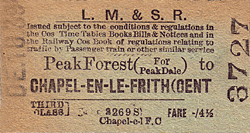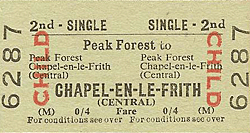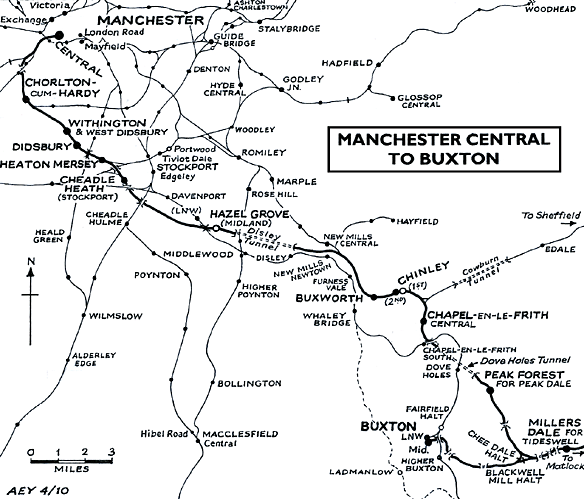Notes: Peak Forest station was located on the Midland Railway (MR) main line route that ran between Manchester Central and Ambergate.
The MR had opened a line in stages between Ambergate and Buxton by the 1st June 1863. However the company's real goal was to get to Manchester. The original idea had been for the line to continue westwards from Buxton but opposition from the London North Western Railway (LNWR) and geological factors forced the MR to think again.
 |
As the line to Buxton was nearing completion the MR began to look for alternative routes. A route from Blackwell Mill which lay to the east of Buxton to Chinley and Marple looked favourable. During the Autumn of 1861 the MR chairman Mr Beale, along with the deputy Chairman Mr Hutchinson and the company general manager James Allport, were visiting |
the proposed route for the line which had been surveyed by company engineers. Whilst driving down a narrow lane they came across a cart which was carrying the Director and two officers of the Manchester Sheffield and Lincolnshire Railway (MSLR). The two groups got to talking and discovered that each was looking at the same route for a railway. Rather than waste time and energy competing against each other the group retired to a hostelry for food and drink. They spent the rest of the day together and reached an accord.
| The MSLR had recently received an Act that would allow it to build a line from Hyde near Manchester to New Mills. It was agreed that if the MR could build a line from Blackwell Mill to the proposed MSLR line then both companies would benefit. The MR could have a route to Manchester by using MSLR metals and the MSLR could have access to the Peak District and |
 |
beyond.
In 1862 an act was passed giving the MR authority to build a line from Blackwell Mill to Chinley and beyond to make an end on connection with the MSLR line at New Mills. The act was called the ‘Rowsley and Buxton Extension Line’.
The MR was very interested in the part of the route that passed through Great Rocks Dale and Peak Forest as there were many quarries opening up that would prove to be a good source of income for the company.
A site was picked for a station which would serve the area. The location was an equal distance between the settlements of Peak Forest and Dove Holes. The location for a station had been decided on the 19th October 1863 during a tour of inspection.
 |
The line opened to good traffic on 1st October 1866. Passenger services were to have commenced on 1st November, but a landslip at Bugsworth resulted in its closure while a new deviation was constructed. The line re-opened for goods traffic on 24th January 1867 and to passenger traffic on 1st February. The station was located on the south side of an overbridge which
|
carried the road between Buxton and Peak Forest. The station was provided with two platforms. The main building was located on the west side of the line on the Manchester direction platform. It was a brick building that had a single storey booking office attached to a two storey station master's house. On the London/Buxton direction platform a simple brick built waiting shelter was provided. The station was built by a local contractor called John Ashwell. An approach road led to the main station building and a path linked to the southbound platform. Passengers had to cross from one side of the line to the other by using the road bridge or a barrow crossing at the north end of the platform.
Extensive goods facilities were provided so that local quarry traffic could be captured. The goods facilities developed over the years to such a degree that they dwarfed the passenger station.
Peak Forest Station was quite some distance from the nearest villages at Dove Holes and Peak Forest. From the start it was served mostly by local trains running between Buxton and Manchester and between Derby and Manchester.
| On the 26th September 1893 the station was renamed as Peak Forest for Peak Dale.Peak Forest generated a considerable amount of revenue, though this was mainly from goods and mineral traffic. In 1899 a total of £511 was received from the sale of 21,471 tickets, and a further £314 from parcels, etc., making a total of £825, against staff costs of around £250 per annum. It |
 |
is noticeable, however, that the average revenue per ticket was less than 6d, indicating that most journeys were to Buxton, Millers Dale, and Chapel-en-le-Frith.
By the early 1920s about 80 people per day used Peak Forest station. In 1922 the station was served by nine northbound trains and eight southbound. Four of the northbound services had originated at Derby and traveled on to Manchester Central. Three of the services going north had originated from Buxton and went forward to Chinley. Two services ran from Buxton to Manchester. In the southbound direction passengers at Peak Forest station had four services to Buxton and four to Derby.
In 1923 Peak Forest station became part of the London Midland and Scottish Railway (LMS). The LMS expanded the service to eleven trains in each direction but fewer of them went forward to Manchester passengers having to change at Chinley.
 |
During the 1930s there was a Station Master at Peak Forest station who took to stopping express services so that some of his customers could have an easier journey. On one occasion he stopped a London St Pancras service so that a senior director of ICI could board it. The Station Master was summoned to Derby to explain his actions to management. He pointed out |
to his superiors just how much money the LMS earned from ICI and he kept his job.
During the Second World War train services were reduced to seven northbound and six southbound services. On the 1st January 1948 Peak Forest station became part of the nationalised British Railways (London Midland Region).
By the 1960s there were only four southbound services and six northbound trains still calling at Peak Forest. Peak Forest lost its goods service on 15th January 1964 although private sidings remained open and are still open. On the 14th June 1965 the station's name reverted to simply Peak Forest (though this shortened name had been used on tickets from about 1940).. The Beeching Report of 1963 had recommended the closure of all the stations between Matlock and Chinley. Peak Forest closed to passenger services on the 6th March 1967.
| In 1968 the last through express passenger services operated on the MR line between Manchester and Ambergate. Peak Forest had always been dominated by the Limestone quarrying industry. Because of this the line through Peak Forest station has remained open and the station site is surrounded by busy sidings. The station itself did lose its platforms after closure but the |
 |
building is very much intact. It has been used since closure as office accommodation and a train crew sign on point for at first BR and in the post 1994 privatisation era by EWS and more recently by DB Shenker.
Through Limestone Hills by Bill Hudson. Published by OPC 1989 ISBN 978-0860932178
Other web sites: Peak Rail now providing a regular steam service between Matlock and Rowsley. David Hey's Collection - Transition from BR steam. Includes railway photographer ER Morten's photographic tour from Buxton - Derby.
Eight and a half miles of the Matlock - Buxton line now forms the Monsal Trail starting at Coombs Road Viaduct, one mile southeast of Bakewell and finishing at the head of Chee Dale, about three miles east of Buxton. There is a diversion round the tunnels.
Further reading: Railway from Buxton to Bakewell, Matlock and Ambergate (Scenes from the Past) by JM Bentley, 1992. Railways around Buxton by JM Bentley, 1987.
Additional source Glynn Waite. Tickets from Michael Stewart and Glynn Waite, 1588 is the last ticket sold at Peak Forest; it was issued to Glynn Waite who used it to get home. Route map drawn by Alan Young
To see other stations between Manchester Central & Matlock click on the station name:Manchester Central, Chorlton-cum-Hardy, Withington & West Didsbury, Didsbury, Heaton Mersey, Cheadle Heath, Hazel Grove (Midland), Buxworth, Chinley (2nd site) STILLOPEN, Chinley (1st site), Chapel-en-le-Frith Central, Cheedale Halt, Buxton (Midland), Blackwell Mill Halt, Millers Dale, Monsal Dale, Great Longstone, Hassop, Bakewell, Rowsley (Second site), Rowsley (First site), Rowsley South PEAK RAIL, Darley Dale, Matlock Riverside PEAK RAIL & Matlock STILL OPEN. See also Stockport Tiviot Dale & Stockport Portwood |

forest_old7.jpg)


forest_old4.jpg)
forest_old2.jpg)
forest_old9.jpg)
forest_old6.jpg)
forest14.jpg)
forest5.jpg)
forest16.jpg)









 Home Page
Home Page